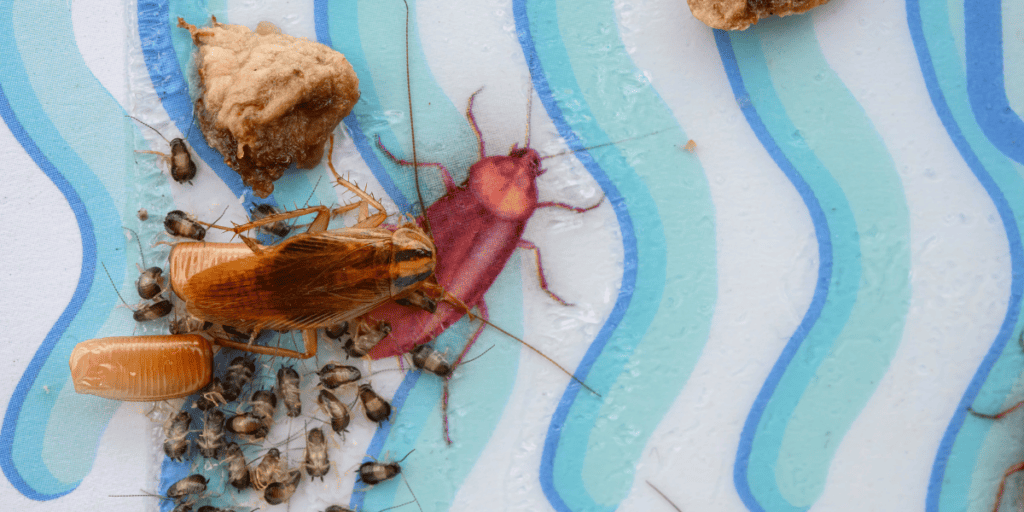Cockroaches reproduce rapidly, with females producing several egg cases, each containing multiple eggs. This article details their reproductive process and why quick action is vital in controlling their population.
POINTS
- Cockroaches have a unique mating process where females attract males using pheromones, and after mating, females lay eggs in a protective case called an ootheca.
- The reproduction rate of cockroaches is high, with some species capable of producing a new generation every few months, leading to exponential population growth if not managed.
- Environmental conditions such as temperature, humidity, and availability of food greatly influence the reproductive cycle and growth rate of cockroaches.
- Cockroaches undergo incomplete metamorphosis, starting as nymphs that molt multiple times before becoming adults, a process that can vary in duration based on species and environmental factors.
- Preventive measures including reducing moisture, sealing entry points, and maintaining cleanliness can disrupt cockroach reproduction and help control their populations.
Fundamentals of Cockroach Reproduction
Understanding the reproductive habits of cockroaches is essential for effective pest control. These resilient pests have developed complex and efficient ways to multiply, which can make managing their populations challenging. In this section, we’ll delve into the basics of cockroach reproduction, including their mating rituals, fertilization, egg-laying, and the variations that exist among different species.
The Mating Process and Egg Development in Cockroaches
How Do Cockroaches Mate?

Cockroaches engage in a unique mating process that begins with a courtship ritual. The female releases pheromones to attract males, who then respond with their own set of signals. When a male finds a receptive female, he presents his spermatophore, a package of sperm, which the female accepts into her genital tract. This exchange is crucial for fertilization and subsequent egg production.
Where Do Cockroaches Lay Eggs?

After fertilization, female cockroaches lay their eggs in a protective case called an ootheca. The ootheca safeguards the eggs from environmental threats and predators. Cockroaches tend to deposit their oothecae in concealed, safe areas such as cracks, crevices, or behind furniture, ensuring the best chance for their offspring’s survival.
From Egg-Laying to Hatching
The journey from egg-laying to hatching varies among cockroach species. For example, the German cockroach carries her ootheca until the eggs are ready to hatch, while others, like the American cockroach, deposit the ootheca shortly after formation. The incubation period can last from a few weeks to several months, depending on the species and environmental conditions.
Reproduction Rates and Frequency in Cockroaches
How Quickly Do Roaches Reproduce?
Cockroaches are notorious for their rapid reproduction rates. A single female can produce multiple oothecae throughout her lifetime, each containing numerous eggs. Some species, like the German cockroach, can produce a new generation every few months, leading to exponential population growth if left unchecked.
How Fast Can Cockroaches Reproduce?
The speed at which cockroaches reproduce is influenced by factors such as species, availability of food, and environmental conditions. In ideal conditions, cockroaches can reproduce quickly, with some species capable of increasing their numbers significantly in a matter of weeks.
How Many Eggs Do Roaches Lay a Day?

The number of eggs laid by cockroaches varies by species. For instance, the German cockroach’s ootheca typically contains around 30 to 40 eggs, while the larger American cockroach’s ootheca may contain closer to 16 eggs. It’s important to note that cockroaches don’t lay eggs daily; instead, they produce oothecae at intervals throughout their reproductive life.
Misconceptions and Unique Reproductive Traits
Are Roaches Asexual?
While some invertebrates can reproduce asexually, cockroaches typically do not. They require a mating process involving a male and female to produce offspring. However, there are rare cases where females can produce offspring without males, a phenomenon known as parthenogenesis, but this is not the norm for cockroach reproduction.
Do Male Cockroaches Lay Eggs?
There is a common misconception that male cockroaches can lay eggs. This is not true; only female cockroaches have the ability to produce and lay oothecae. Male cockroaches play a role in fertilization but do not participate in egg-laying.
Lifespan, Growth, and Environmental Influences on Reproduction
To fully grasp the challenge of controlling cockroach populations, it’s important to consider their lifespan, growth stages, and how environmental factors influence their reproductive capabilities.
How Do Roaches Grow?
Cockroaches undergo incomplete metamorphosis, which means they hatch from eggs as nymphs and resemble smaller versions of the adult cockroaches. These nymphs molt several times as they grow, shedding their exoskeletons and gradually taking on the size and characteristics of adults. This growth process can take anywhere from a few months to over a year, depending on the species and environmental conditions.
How Fast Do Roaches Multiply?
The multiplication rate of cockroaches is alarming. A single female and her offspring can theoretically produce thousands of descendants in a year, given the right conditions. This rapid multiplication is why small infestations can quickly become large-scale problems if not addressed promptly.
The Effect of Environmental Conditions on Reproductive Cycle
Cockroaches thrive in warm, humid environments with access to food and water. When these conditions are met, their reproductive cycle accelerates, leading to more frequent egg-laying and faster development of nymphs into adults. Conversely, suboptimal conditions can slow down their reproduction and development. Factors such as temperature, humidity, and resource availability play significant roles in the reproductive success of cockroach populations.



